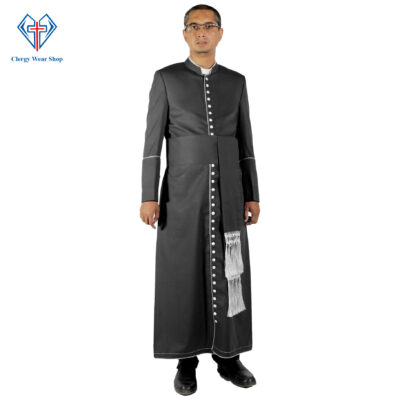Clergy Robes for Men
Why Do Priests Wear Black?
Exploring Why Priests Wear Black
Why Do Priests Wear Black? Priests wear black for several reasons, deeply rooted in tradition and symbolism. Firstly, black represents humility and piety, emphasizing the priest’s commitment to spiritual matters over worldly desires. Additionally, black attire signifies solemnity and reverence, fitting for their role in leading religious ceremonies and rites. Historically, black has been associated with mourning and penance, highlighting the priest’s readiness to guide and comfort during times of grief and reflection. Overall, the choice of black attire reflects the priest’s dedication to serving a higher purpose and fostering spiritual growth within their community.
The Tradition of Clergy Robes for Men
The tradition of clergy robes for men has endured for centuries, steeped in rich historical and religious significance. These robes, often called cassocks, serve as iconic symbols of the clergy’s devotion and humility. From their origins in ancient religious practices to their modern adaptations, clergy robes reflect a commitment to spiritual service and a renunciation of worldly pursuits. Across denominations and cultures, the tradition of donning these distinctive garments remains a steadfast reminder of the sacred duties undertaken by clergy members.

Representation of the Black Clergy Attire
The representation of black clergy attire among clergy members holds profound symbolic significance. Black embodies humility, piety, and a detachment from worldly desires, reflecting the clergy’s dedication to spiritual pursuits. Additionally, black serves as a symbol of solemnity and reverence, particularly during periods of mourning or penance. Across cultures and religions, the choice of black robes underscores the clergy’s commitment to embodying virtues of modesty and devotion. Through their attire, clergy members convey a powerful message of spiritual integrity and service to their communities.
Historical backdrop
Throughout history, the clergy have often been associated with asceticism and austerity. Black, as a color, embodies these principles, signifying a detachment from material desires and a focus on spiritual matters. Additionally, during times of mourning or penance, black attire is traditionally worn as a symbol of solemnity and reverence.
Evolution of Clergy Attire
While the traditional black cassock remains a staple in clergy attire, there have been variations and adaptations over time. Modern clergy robes for men may include subtle embellishments or modifications to reflect individual preferences or denominational practices. However, the underlying symbolism of humility and devotion remains unchanged.
Black Clergy Cassock
The clergy cassock in black is a timeless symbol of reverence and devotion. This traditional garment, often worn by clergy members, signifies their commitment to spiritual service and humility. The black color of the cassock represents a renunciation of worldly desires and a focus on higher principles. Additionally, the simplicity of the black cassock emphasizes the clergy’s dedication to modesty and piety. Across denominations, the clergy cassock in black remains an iconic representation of the sacred duties undertaken by religious leaders.
Clergy Shirts for Mens

Clergy shirts for men play a pivotal role in clerical attire, reflecting their sacred vocation and commitment to spiritual service. These shirts, often in black or other subdued colors, serve as a distinctive marker of their role within the clergy. Beyond mere clothing, clergy shirts symbolize humility, piety, and a renunciation of worldly pursuits. Whether worn under a cassock or as standalone attire, clergy shirts embody the values and principles upheld by religious leaders in their daily lives and sacred duties.
Cultural Influences
The choice of black attire among priests is also influenced by cultural norms and traditions. In some societies, black is associated with authority, wisdom, and solemnity, making it an appropriate choice for religious leaders. Additionally, the uniformity of clergy attire fosters a sense of unity and solidarity within religious communities.
Practical Considerations
Beyond its symbolic significance, black attire offers practical benefits for clergy members. The dark color helps conceal stains and wear, ensuring that priests maintain a dignified appearance during religious ceremonies and rituals. Moreover, the simplicity of black robes underscores the idea of modesty and humility, aligning with the principles of many religious doctrines. Why Do Priests Wear Black?
In conclusion, the tradition of priests wearing black attire encompasses a rich tapestry of historical, symbolic, and practical elements. From its origins rooted in religious asceticism to its contemporary significance as a symbol of humility and devotion, black remains a timeless choice for clergy robes. By understanding the deeper meanings behind this tradition, we gain insight into the spiritual journey undertaken by clergy members as they fulfill their sacred duties. Why Do Priests Wear Black?
Frequently Asked Questions (FAQs)
Why do priests wear black with a white collar?
Priests wear black with a white collar as a distinctive symbol of their clerical status. The black attire signifies humility, piety, and a renunciation of worldly desires, while the white collar, known as a clerical collar or Roman collar, serves as a visible reminder of their ordained role within the Church. It also represents purity and serves as a symbol of the priest’s commitment to spiritual service.
Are priests required to wear black?
While there isn’t a universal requirement for priests to wear black, it is a customary practice within many Christian denominations. The choice of attire may vary depending on the traditions and guidelines of the specific religious order or diocese to which the priest belongs. However, black attire is widely recognized as a traditional symbol of clergy members’ commitment to their vocation.
When did priests start wearing black?
The tradition of priests wearing black attire dates back centuries, with its origins rooted in historical and religious contexts. While the exact timeframe may vary depending on the region and denomination, black garments have been associated with clergy members’ humility and dedication to spiritual service for many centuries.
Why do priests wear black vestments?
Priests wear black vestments, particularly during religious ceremonies such as Mass or funeral services, as a symbol of solemnity and reverence. Black vestments are traditionally worn during periods of mourning or penance, underscoring the priest’s role in guiding and comforting the faithful during times of grief and reflection.
Can priests wear white?
While priests typically wear black attire as a symbol of their clerical status, there are occasions when they may wear white garments. For example, white may be worn during liturgical celebrations such as weddings, baptisms, or Easter Sunday Mass, symbolizing purity, joy, and the resurrection of Christ. However, the specific guidelines regarding the use of white attire may vary depending on the customs and traditions of the particular religious institution.
What is a priest’s black outfit called?
A priest’s black outfit is commonly referred to as a cassock or clerical robe. The cassock is a long, flowing garment worn by clergy members, typically reaching to the ankles and often accompanied by a white clerical collar. It serves as a symbol of the priest’s dedication to their vocation and their commitment to leading a life of humility and service.

 Clergy Cassocks for Men
Clergy Cassocks for Men Clergy Cassocks for Women
Clergy Cassocks for Women Clergy Robes for Women
Clergy Robes for Women Clergy Shirts for Men
Clergy Shirts for Men Clergy Shirts for Women
Clergy Shirts for Women